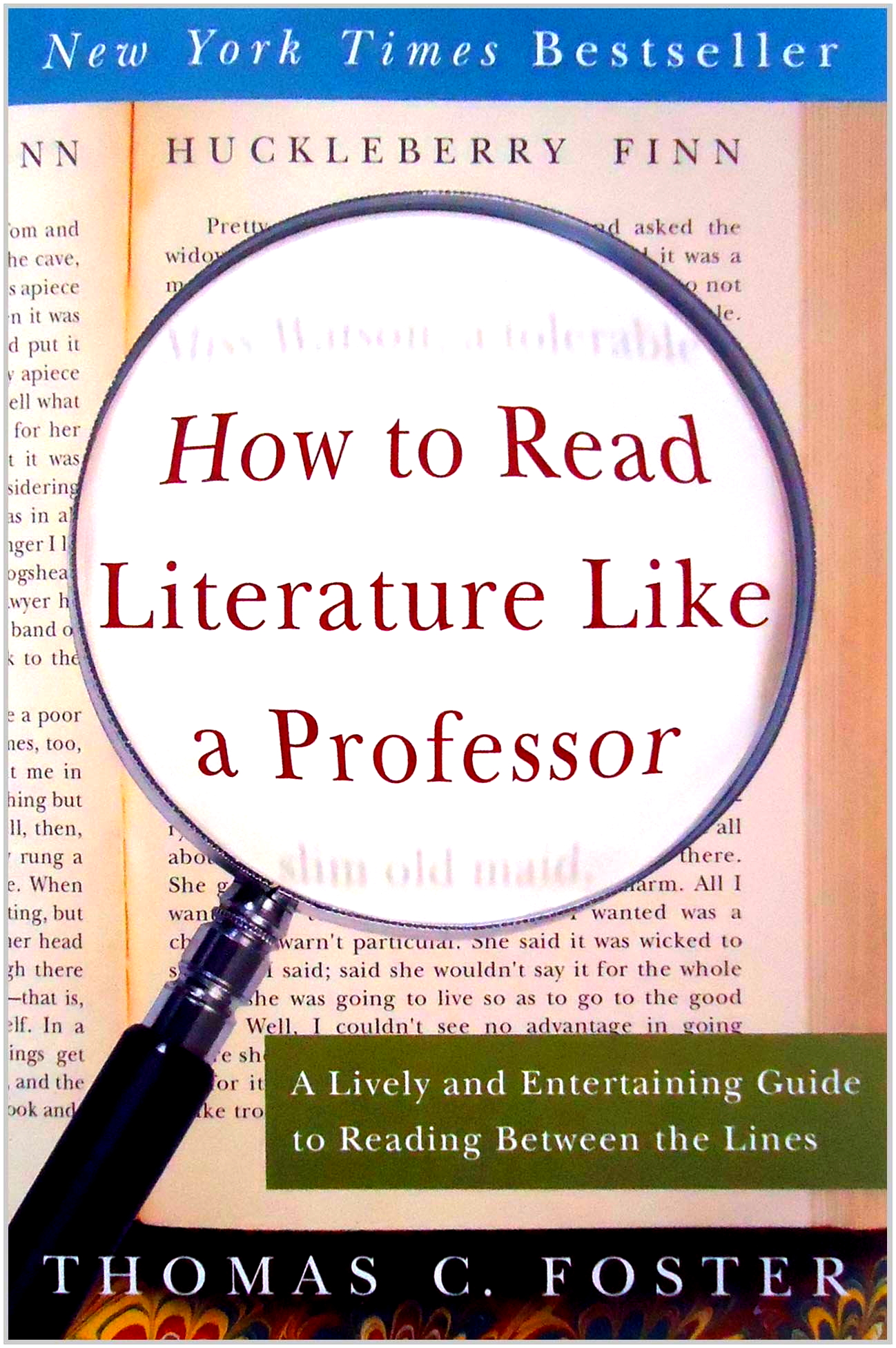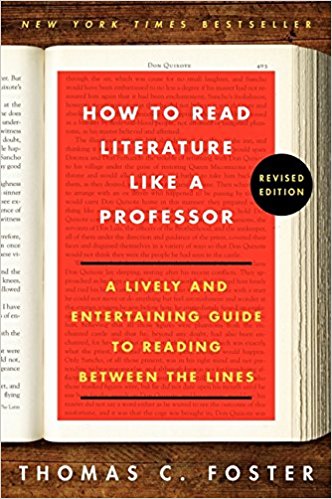How to Read Like a Professor Introduction
In Arthur Conan Doyle'southward "The Red-Headed League," Sherlock Holmes and Dr. John Watson both observe Jabez Wilson carefully, still their differing interpretations of the same details reveal the difference between a "Adept Reader" and a "Bad Reader." Watson tin can simply describe what he sees; Holmes has the knowledge to interpret what he sees, to draw conclusions, and to solve the mystery.
Understanding literature need no longer be a mystery -- Thomas Foster's book will help transform you lot from a naive, sometimes confused Watson to an insightful, literary Holmes. Professors and other informed readers see symbols, archetypes, and patterns considering those things are in that location -- if you take learned to look for them. As Foster says, you lot acquire to recognize the literary conventions the "same fashion you become to Carnegie Hall. Practice." (xiv).
 How to Read Literature Like a Professor:
How to Read Literature Like a Professor:
A Lively and Entertaining Guide to Reading Between the Lines
by Thomas C. Foster Full TEXT 
Also available in a revised second edition, with significant changes. FULL TEXT
Note to teachers: LitCharts has chapter handouts and a Teacher Guide. Harper Collins Instructor Guide presents challenging analytical writing and is correlated with Common Core. PowerPoint version of Marti Nelson'south notes (sent to me past an unnamed contributor). Literary Guideposts from Oak Park Loftier Schoolhouse combines notes and questions (by Enoch and Rohlfs). Thomas Foster Meets Kate Chopin requires that students apply Foster to "The Story of an Hour" (by Rebecca Mooring).
Teachers Pay Teachers offers workheets and quizzes on the book. In particular, AP Lit and More, Gina Kortuem's store materials are adapted for the 2019 CED and could largely stand up without the text through the daily Bellringers. Just in time for altitude learning, Kortuem has added a Hyperdoc Unit of measurement that works in Google Slides, complete with bellringers, lesson principles, application, boosted information, and a various written responses.
Note to students: These short writing assignments will let y'all practice your literary analysis and they will help me become to know you and your literary tastes. Whenever I ask for an case from literature, you may use curt stories, novels, plays, or films (Yes, motion picture is a literary genre). If your literary repertoire is thin and undeveloped, use the Appendix to jog your memory or to select additional works to explore. At the very least, sentry some of the "Movies to Read" that are listed on pages 293-294. Please note that your responses should be paragraphs -- non pages!
Even though this is belittling writing, yous may employ "I" if you deem it of import to practise so; retrieve, notwithstanding, that most uses of "I" are just padding. For example, "I recollect the wolf is the most important character in 'Little Scarlet Ridinghood'" is padded. Every bit you etch each written response, re-phrase the prompt as part of your answer. In other words, I should exist able to tell which question you are answering without referring back to the prompts.
Apropos mechanics, pay special attention to pronouns. Make antecedents articulate. Say Foster first; not "he." Remember to capitalize and punctuate titles properly for each genre.
Assignments beneath are for the first edition. They are re-listed, with appropriate additions, for the second edition on its page. You lot may download a set of Notes (past Marti Nelson) on this book to help y'all in your analysis. Also a re-create of these assignments (Word or every bit .PDF) and a Grading Checklist (Discussion or as .PDF).
Introduction: How'd He Do That?
How do memory, symbol, and pattern affect the reading of literature? How does the recognition of patterns arrive easier to read complicated literature? Talk over a time when your appreciation of a literary piece of work was enhanced past understanding symbol or pattern.
Chapter 1 -- Every Trip Is a Quest (Except When It'south Non)
List the 5 aspects of the QUEST then use them to something you have read (or viewed) in the form used on pages 3-5.
Chapter 2 -- Dainty to Eat with You: Acts of Communion
Choose a repast from a literary piece of work and apply the ideas of Affiliate two to this literary depiction.
Affiliate 3: --Nice to Eat You: Acts of Vampires
What are the essentials of the Vampire story? Apply this to a literary work you take read or viewed.
Chapter 4 -- If It's Square, It's a Sonnet
Select three sonnets and show which grade they are. Discuss how their content reflects the course. (Submit copies of the sonnets, marked to testify your analysis).
Chapter 5 --Now, Where Have I Seen Her Before?
Ascertain intertextuality. Discuss iii examples that have helped you in reading specific works.
Chapter 6 -- When in Doubt, It's from Shakespeare...
Discuss a work that y'all are familiar with that alludes to or reflects Shakespeare. Show how the writer uses this connection thematically. Read pages 44-46 advisedly. In these pages, Foster shows how Fugard reflects Shakespeare through both plot and theme. In your discussion, focus on theme.
Chapter vii -- ...Or the Bible
Read "Araby" (available here). Hash out Biblical allusions that Foster does not mention. Look at the example of the "ii smashing jars." Be creative and imaginative in these connections.
Chapter viii -- Hanseldee and Greteldum
Think of a work of literature (including film) that reflects a fairy tale. Discuss the parallels. Does it create irony or deepen appreciation?
Chapter nine -- It's Greek to Me
Write a complimentary poesy poem derived or inspired by characters or situations from Greek mythology. Be prepared to share your poem with the class. Greek mythology available online.
Affiliate 10 -- It'southward More Than Just Rain or Snowfall
Hash out the importance of weather in a specific literary work, not in terms of plot.
Interlude -- Does He Mean That
Chapter 11 --...More than It'southward Gonna Injure Yous: Concerning Violence
Present examples of the two kinds of violence establish in literature (including film). Show how the effects are dissimilar.
Chapter 12 -- Is That a Symbol?
Utilise the procedure described on page 106 and investigate the symbolism of the argue in "Araby." (Mangan's sister stands behind information technology.)
Chapter thirteen -- It's All Political
Assume that Foster is right and "it is all political." Use his criteria to testify that 1 of the major works assigned in a previous year is political.
Chapter fourteen -- Yes, She'southward a Christ Figure, Too
Apply the criteria on page 119 to a major character in a significant literary work. Try to choose a graphic symbol that will accept many matches. This is a particularly apt tool for analyzing film -- for case, Star Wars, Cool Hand Luke, Excalibur, Malcolm 10, Braveheart, Spartacus, Gladiator and Ben-Hur.
Chapter 15 -- Flights of Fancy
Select a literary piece of work in which flight signifies escape or freedom. Explain in detail.
Chapter 16 -- It's All About Sex...
Affiliate 17 -- ...Except the Sexual practice
OK ..the sex capacity. The key idea from this chapter is that "scenes in which sex is coded rather than explicit can work at multiple levels and sometimes be more intense that literal depictions" (141). In other words, sex activity is often suggested with much more than art and try than information technology is described, and, if the author is doing his job, it reflects and creates theme or grapheme. Cull a novel or moving-picture show in which sexual activity is suggested, but not described, and discuss how the human relationship is suggested and how this implication affects the theme or develops label.
Affiliate 18 -- If She Comes Upwardly, Information technology'due south Baptism
Recollect of a "baptism scene" from a meaning literary work. How was the character different subsequently the experience? Discuss.
Chapter xix -- Geography Matters...
Discuss at least four different aspects of a specific literary piece of work that Foster would classify nether "geography."
Chapter xx -- ...So Does Flavor
Notice a poem that mentions a specific season. Then discuss how the poet uses the season in a meaningful, traditional, or unusual way. (Submit a copy of the poem with your assay.)
Interlude -- One Story
Write your own definition for archetype. Then place an archetypal story and use it to a literary piece of work with which yous are familiar.
Affiliate 21 -- Marked for Greatness
Why do writers give characters in literature deformities? Figure out Harry Potter's scar. If you aren't familiar with Harry Potter, select another character with a physical imperfection and analyze its implications for characterization.
Chapter 22 -- He's Blind for a Reason, You Know
If information technology is difficult to write a story with a bullheaded character, why might an writer include one? Explain what Foster
calls the "Indiana Jones Principle".
Affiliate 23 -- It's Never Only Center Disease...
Chapter 24 -- ...And Rarely Only Illness
Why does Foster consider centre affliction the all-time, most lyrical, almost perfectly metaphorical illness? Think two characters who died of a disease in a literary work. Consider how these deaths reflect the "principles governing the use of disease in literature" (215-217). Discuss the effectiveness of the death equally related to plot, theme, or symbolism.
Affiliate 25 -- Don't Read with Your Optics
After reading Affiliate 25, choose a scene or episode from a novel, play or epic written before the twentieth century. Contrast how it could exist viewed by a reader from the twenty-commencement century with how information technology might be viewed by a contemporary reader. Focus on specific assumptions that the author makes, assumptions that would not brand information technology in this century.
Affiliate 26 -- Is He Serious? And Other Ironies
Select an ironic literary work and explain the multivocal nature of the irony in the piece of work.
Chapter 27 -- A Test Case
Read "The Garden Party" by Katherine Mansfield, the short story starting on page 245. Complete the practice on pages 265-266, following the directions exactly. And so compare your writing with the iii examples. How did you practise? What does the essay that follows comparison Laura with Persephone add to your appreciation of Mansfield's story?
Envoi
Choose a motif not discussed in this book (as the horse reference on page 280) and note its advent in three or four different works. What does this idea seem to signify?
Adjusted from Assignments originally developed past Donna Anglin. Notes by Marti Nelson.
Source: https://mseffie.com/assignments/professor/professor.html
0 Response to "How to Read Like a Professor Introduction"
Post a Comment